4 to 10 July, 2009 – Cienfuegos, Trinidad, Santa Clara, and Camagüey, Cuba
Sometimes you feel you want to laugh. And then there are the moments you feel you could just about cry. Cuba thrusts many trying moments upon you. However, when they are at their worst, it is necessary to remind yourself that they are only passing annoyances for us, while the Cuban people live with things day to day.
Rationing is enforced on many products. Not rum or beer, which flow freely from every shop at every hour. Walk into a small grocery shop, and you are sure to find shelves of alcohol, and cheap, too. Nobody would look at you twice if you bought a bottle of rum at 9 in the morning. In fact, they get taken aback if you ask for something else, like water, and they gesture at their shelves telling you that there is no water, but surely a bottle of something stiffer will compensate.
Aside from alcohol, and a few other select products, almost everything else seems to be rationed or in short supply. Rows of empty shelves, or full of the same products. Just today I went in to a “supermarket” with pictures on the windows of dozens of fancy items. Aside from the alcohol, there were only 5 or 6 other products available, spread out so that each one took up an entire counter or multiple shelves. There was a queue out the door and down the street of people lining up for galletas – crackers.
Why do scenes like this seem to be synonymous with Communism? It's almost expected in countries with full-on Socialism. We have wandered the streets for hours looking for things which should be easy to locate in most countries. Fresh milk is impossible to find. Powdered milk is only available with a ration book.
Service standards are appallingly low. Service is not generally offered, you need to ask for assistance. There are exceptions, but most shop attendants and wait staff seem less than interested in performing their functions. They don't complain, but they don't go on a limb. Stand at a counter and look expectant, and you will be ignored. “Disculpe”, and someone will turn to you and smile. Ask a question, and they will answer. It is an uphill battle to get to this point, but you finally have them engaged. In most countries, they would now wait until you have indicated you have no more questions, that you need no more assistance, before they would leave you. They would probably confirm it with a “Can I help you with anything more?”, but not here. They answer the question you ask and turn or walk off, requiring effort on your part to re-engage them. In a restaurant, if you want to ask about three dishes, you may lose your waiter while taking a breath between questions.
It is so draining. And after three or four incidents in a morning, you feel wrung out. Do you laugh? Do you cry? No, you sit with your spouse and vent over an espresso. These are generally available, and generally very cheap (like 6 cents, or as low as 1.5 cents). This in itself starts restoring and revitalising, and after a bit of venting, things seem to slip back in to some sort of perspective. Except, of course, if the 24 hour coffee bar which only sells coffee and cigarettes, has run out of coffee. Yes, that happens too. Then you are just about pushed over the edge.
Coffee bars without coffee. Bars without beer (or only warm beer). Restaurants with twenty choices on the menu, but “we only have the fried chicken”. These we have encountered not just once or twice, but often. The extensive and useless menu is actually par for the course – we have now come to expect that the dishes we have decided upon will be unavailable. The waiter doesn't tell you this when you order. No, you start to imagine that you will actually get those oven baked ribs you chose. And then, five minutes later, the waiter wanders out from the kitchen, and you know they are heading your way. Sorry, there are no ribs. There is roast chicken or fried chicken. Yep, should've known.
Ooh, that restaurant looks popular – look at the queue. Hmm, ten tables, and only four occupied. Door is locked, but nobody minds. They wait. A couple leaves, and a waiter lets a few more in, and the queue shortens a bit. Later, some more leave, nobody let in just yet. Then randomly, five minutes later, some more go in. This is definitely one to make you laugh.
Only in a Communist country can you serve a plate of dry chopped cabbage and tell the customer that it's the salad.
30 cent street pizzas. These never run out. A slab of dough with tomato sauce and cheese. For a bit extra, some ham or chorizo. No cutting these. Fold them in half and start. 3 cent icecream scoops. Give me 4. The queues for these go half a block. The line seems disorderly. “¿Ultimo”, “Who's last?” you ask as you approach. Someone will smile at you, or raise their hand. They may not be at the back of the queue, as it is not a strict line, everyone just mills about. Anyway, you just keep your eye on them, and when someone else arrives, let them know you are the end of the queue. It just works.
So, a lot of the street food can be bought in street money, or monedas nacionales. When you deal in these pesos, expect everything to be cheap. Cuba, however, has two currencies. The second currency is known as Pesos Convertibles, or CUCs. These are for foreigners, and this is where you can watch your money disappear. Technically, foreigners are expected to pay for everything with convertibles. And sometimes it is quite clear. Entry to a museum – 3 pesos for locals, 3 CUCs for foreigners. Oh, a CUC is worth 24 to 25 pesos. Some waiters will try and insist that the price of the coffee must be paid in convertibles – 1 peso for locals, 1 CUC for foreigners, effectively trying to force us to pay 25 times what locals pay. You need to be clear before you begin that you are expecting to pay in pesos. Sometimes the CUC makes something sound cheap. A taxi for 3 kilometres – only 5 CUCs! Bargain hard, and still expect to be paying way too much. If you get him down to 2 CUCs, and sometimes you can, you know that locals probably pay 5 to 10 pesos. At least you are only paying 4 or 5 times what they are, not 15 or 20.
Sometimes you can't do much to avoid paying the inflated price. Locals pay a fraction of what foreigners do for buses. Many routes have one or two buses a day with tickets payable in CUCs only. When these buses exist, you are not just steered away, but practically barred from taking the bus with the locals. There is not a lot you can do in this situation, but then when the person putting your bag on wants a tip, and asks brazenly for a CUC per bag, which is hours work for most Cubans, ooh, that gets my back up. I politely decline, but most foreigners seem happy enough to hand it over.
Some locals seem to have the attitude we are made of money, or that value for money is not a priority for us. That we should be just willing to hand out what they ask, because it is only money, and we are not discerning. Some pout at the tip which you know is a decent amount.
And foreigners handing out small bits of money here and there, small to them and big to locals, have created an interesting by-problem. We read somewhere that a beggar in a touristy spot, particularly in Havana, can make more money than a Cuban teacher or doctor. No wonder they come out in droves to hassle us when we are trying to enjoy the sights. “Just one CUC?' they ask. They only need 4 or 5 a day and they are doing very well.
My goodness. Sorry about all that. Time for a change in topic. Better keep it brief, hey.
Che. Ernesto Che Guevara. Oh, maybe I'll let the photo captions say it, as I have already put some thoughts down. Let me just say that he pops up everywhere, on all sorts of things. I'm sure he wouldn't mind that his image and his memory are used to continually promote the revolutionary cause. However, the amount of commercialism that uses his image, and that one particularly famous high contrast image, they may be considered counter to what he stood for.
This week has been about Colonial towns, music and dance, food, and history. The photos tell some stories.
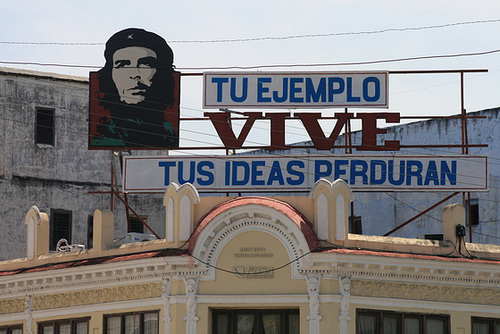
The Ubiquitous Che
Poster boy for propaganda everywhere. “Your example lives. Your ideas endure.”
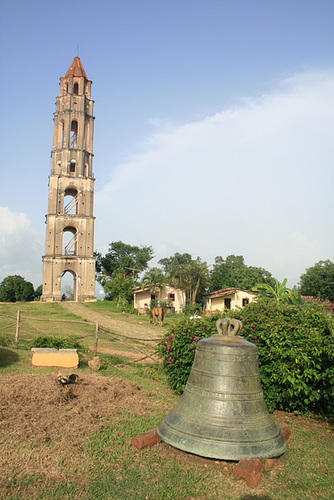
Slave Watchtower And Bell
Manaca Iznaga, in the Valle de los Ingenios.

View From Slave Watchtower
Manaca Iznaga, in the Valle de los Ingenios.
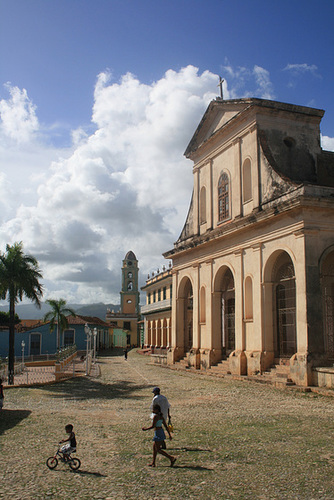
Trinidad, Cuba
Above Plaza Mayor, in Trinidad, on Cuba's south coast.
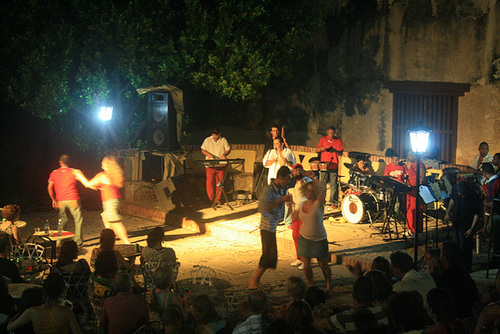
Music And Dance On The Streets Of Trinidad
Various bands, various styles, lots of rhythm.

Taxi, Santa Clara Style
Public transport in many Cuban towns relies on horse drawn vehicles, or trucks for longer stretches. It is hard for us to not romanticise these sorts of things.
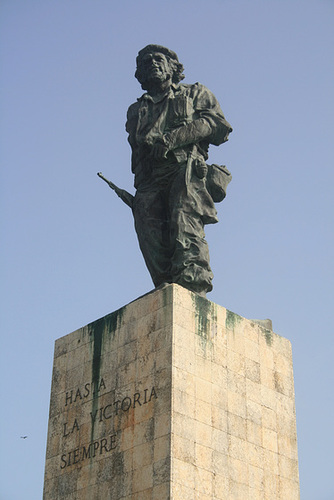
Monument To Che
When Che's remains were recovered from a secret grave beneath a Bolivian airstrip , they were placed in a crypt beneath this memorial. It is a very moving and beautiful memorial with an eternal flame. There is also a small museum with photos of Che from childhood to the last days of his life, as well as many personal effects.
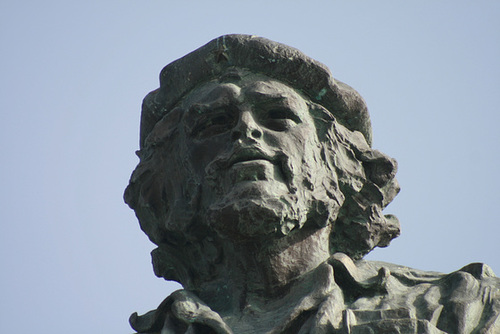
Che
Ever determined.
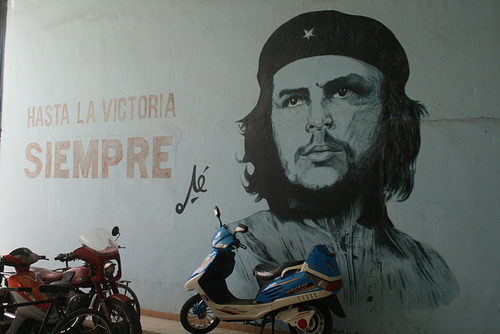
Towards Victory, Always!
Santa Clara was where the revolutionary forces one a significant and decisive battle, with a 18 men under the leadership of Che Guevara taking a 22 car armoured train defended by 350 soldiers, in a battle lasting just 90 minutes. Che became synonymous with Santa Clara, and there are monuments and posters of him everywhere, much more-so than in the rest of Cuba. It is why his remains were eventually brought here, too.

Revolutionary Training
Maybe I've found a cause! (BTW, 20 shots for 6 cents).
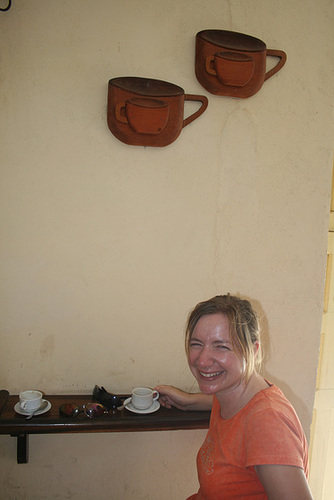
Revitalisation By Caffeine
Street coffees cost about 1.6 cents. Espressos with a dash of milk in a coffee bar like this cost about 5 or 6 cents. Sometimes we splurge.
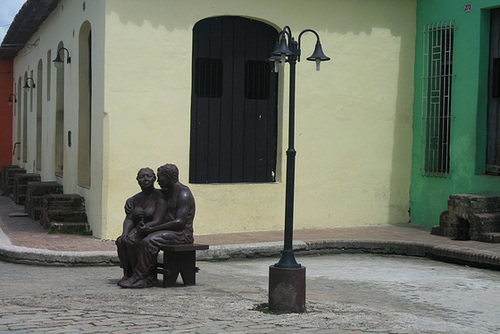
Kissing Couple
A bronze man kisses his bronze lover in the streets of Camagüey, Cuba.

A Typical Cuban
Difficult to understand, hospitable, and always with a cigar in his mouth. Maybe that's part of what makes Cubans difficult to understand!
Sometimes you feel you want to laugh. And then there are the moments you feel you could just about cry. Cuba thrusts many trying moments upon you. However, when they are at their worst, it is necessary to remind yourself that they are only passing annoyances for us, while the Cuban people live with things day to day.
Rationing is enforced on many products. Not rum or beer, which flow freely from every shop at every hour. Walk into a small grocery shop, and you are sure to find shelves of alcohol, and cheap, too. Nobody would look at you twice if you bought a bottle of rum at 9 in the morning. In fact, they get taken aback if you ask for something else, like water, and they gesture at their shelves telling you that there is no water, but surely a bottle of something stiffer will compensate.
Aside from alcohol, and a few other select products, almost everything else seems to be rationed or in short supply. Rows of empty shelves, or full of the same products. Just today I went in to a “supermarket” with pictures on the windows of dozens of fancy items. Aside from the alcohol, there were only 5 or 6 other products available, spread out so that each one took up an entire counter or multiple shelves. There was a queue out the door and down the street of people lining up for galletas – crackers.
Why do scenes like this seem to be synonymous with Communism? It's almost expected in countries with full-on Socialism. We have wandered the streets for hours looking for things which should be easy to locate in most countries. Fresh milk is impossible to find. Powdered milk is only available with a ration book.
Service standards are appallingly low. Service is not generally offered, you need to ask for assistance. There are exceptions, but most shop attendants and wait staff seem less than interested in performing their functions. They don't complain, but they don't go on a limb. Stand at a counter and look expectant, and you will be ignored. “Disculpe”, and someone will turn to you and smile. Ask a question, and they will answer. It is an uphill battle to get to this point, but you finally have them engaged. In most countries, they would now wait until you have indicated you have no more questions, that you need no more assistance, before they would leave you. They would probably confirm it with a “Can I help you with anything more?”, but not here. They answer the question you ask and turn or walk off, requiring effort on your part to re-engage them. In a restaurant, if you want to ask about three dishes, you may lose your waiter while taking a breath between questions.
It is so draining. And after three or four incidents in a morning, you feel wrung out. Do you laugh? Do you cry? No, you sit with your spouse and vent over an espresso. These are generally available, and generally very cheap (like 6 cents, or as low as 1.5 cents). This in itself starts restoring and revitalising, and after a bit of venting, things seem to slip back in to some sort of perspective. Except, of course, if the 24 hour coffee bar which only sells coffee and cigarettes, has run out of coffee. Yes, that happens too. Then you are just about pushed over the edge.
Coffee bars without coffee. Bars without beer (or only warm beer). Restaurants with twenty choices on the menu, but “we only have the fried chicken”. These we have encountered not just once or twice, but often. The extensive and useless menu is actually par for the course – we have now come to expect that the dishes we have decided upon will be unavailable. The waiter doesn't tell you this when you order. No, you start to imagine that you will actually get those oven baked ribs you chose. And then, five minutes later, the waiter wanders out from the kitchen, and you know they are heading your way. Sorry, there are no ribs. There is roast chicken or fried chicken. Yep, should've known.
Ooh, that restaurant looks popular – look at the queue. Hmm, ten tables, and only four occupied. Door is locked, but nobody minds. They wait. A couple leaves, and a waiter lets a few more in, and the queue shortens a bit. Later, some more leave, nobody let in just yet. Then randomly, five minutes later, some more go in. This is definitely one to make you laugh.
Only in a Communist country can you serve a plate of dry chopped cabbage and tell the customer that it's the salad.
30 cent street pizzas. These never run out. A slab of dough with tomato sauce and cheese. For a bit extra, some ham or chorizo. No cutting these. Fold them in half and start. 3 cent icecream scoops. Give me 4. The queues for these go half a block. The line seems disorderly. “¿Ultimo”, “Who's last?” you ask as you approach. Someone will smile at you, or raise their hand. They may not be at the back of the queue, as it is not a strict line, everyone just mills about. Anyway, you just keep your eye on them, and when someone else arrives, let them know you are the end of the queue. It just works.
So, a lot of the street food can be bought in street money, or monedas nacionales. When you deal in these pesos, expect everything to be cheap. Cuba, however, has two currencies. The second currency is known as Pesos Convertibles, or CUCs. These are for foreigners, and this is where you can watch your money disappear. Technically, foreigners are expected to pay for everything with convertibles. And sometimes it is quite clear. Entry to a museum – 3 pesos for locals, 3 CUCs for foreigners. Oh, a CUC is worth 24 to 25 pesos. Some waiters will try and insist that the price of the coffee must be paid in convertibles – 1 peso for locals, 1 CUC for foreigners, effectively trying to force us to pay 25 times what locals pay. You need to be clear before you begin that you are expecting to pay in pesos. Sometimes the CUC makes something sound cheap. A taxi for 3 kilometres – only 5 CUCs! Bargain hard, and still expect to be paying way too much. If you get him down to 2 CUCs, and sometimes you can, you know that locals probably pay 5 to 10 pesos. At least you are only paying 4 or 5 times what they are, not 15 or 20.
Sometimes you can't do much to avoid paying the inflated price. Locals pay a fraction of what foreigners do for buses. Many routes have one or two buses a day with tickets payable in CUCs only. When these buses exist, you are not just steered away, but practically barred from taking the bus with the locals. There is not a lot you can do in this situation, but then when the person putting your bag on wants a tip, and asks brazenly for a CUC per bag, which is hours work for most Cubans, ooh, that gets my back up. I politely decline, but most foreigners seem happy enough to hand it over.
Some locals seem to have the attitude we are made of money, or that value for money is not a priority for us. That we should be just willing to hand out what they ask, because it is only money, and we are not discerning. Some pout at the tip which you know is a decent amount.
And foreigners handing out small bits of money here and there, small to them and big to locals, have created an interesting by-problem. We read somewhere that a beggar in a touristy spot, particularly in Havana, can make more money than a Cuban teacher or doctor. No wonder they come out in droves to hassle us when we are trying to enjoy the sights. “Just one CUC?' they ask. They only need 4 or 5 a day and they are doing very well.
My goodness. Sorry about all that. Time for a change in topic. Better keep it brief, hey.
Che. Ernesto Che Guevara. Oh, maybe I'll let the photo captions say it, as I have already put some thoughts down. Let me just say that he pops up everywhere, on all sorts of things. I'm sure he wouldn't mind that his image and his memory are used to continually promote the revolutionary cause. However, the amount of commercialism that uses his image, and that one particularly famous high contrast image, they may be considered counter to what he stood for.
This week has been about Colonial towns, music and dance, food, and history. The photos tell some stories.

The Ubiquitous Che
Poster boy for propaganda everywhere. “Your example lives. Your ideas endure.”

Slave Watchtower And Bell
Manaca Iznaga, in the Valle de los Ingenios.

View From Slave Watchtower
Manaca Iznaga, in the Valle de los Ingenios.

Trinidad, Cuba
Above Plaza Mayor, in Trinidad, on Cuba's south coast.

Music And Dance On The Streets Of Trinidad
Various bands, various styles, lots of rhythm.

Taxi, Santa Clara Style
Public transport in many Cuban towns relies on horse drawn vehicles, or trucks for longer stretches. It is hard for us to not romanticise these sorts of things.

Monument To Che
When Che's remains were recovered from a secret grave beneath a Bolivian airstrip , they were placed in a crypt beneath this memorial. It is a very moving and beautiful memorial with an eternal flame. There is also a small museum with photos of Che from childhood to the last days of his life, as well as many personal effects.

Che
Ever determined.

Towards Victory, Always!
Santa Clara was where the revolutionary forces one a significant and decisive battle, with a 18 men under the leadership of Che Guevara taking a 22 car armoured train defended by 350 soldiers, in a battle lasting just 90 minutes. Che became synonymous with Santa Clara, and there are monuments and posters of him everywhere, much more-so than in the rest of Cuba. It is why his remains were eventually brought here, too.

Revolutionary Training
Maybe I've found a cause! (BTW, 20 shots for 6 cents).

Revitalisation By Caffeine
Street coffees cost about 1.6 cents. Espressos with a dash of milk in a coffee bar like this cost about 5 or 6 cents. Sometimes we splurge.

Kissing Couple
A bronze man kisses his bronze lover in the streets of Camagüey, Cuba.

A Typical Cuban
Difficult to understand, hospitable, and always with a cigar in his mouth. Maybe that's part of what makes Cubans difficult to understand!
1 comment:
I had no idea that being a tourist in Cuba could be so cheap - or expensive. The rationing would drive me nuts! And what about the cost of tea in a tea house.... or should I move more Far East for that?
Post a Comment